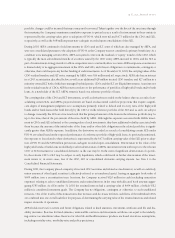American Express 2003 Annual Report Download - page 66
Download and view the complete annual report
Please find page 66 of the 2003 American Express annual report below. You can navigate through the pages in the report by either clicking on the pages listed below, or by using the keyword search tool below to find specific information within the annual report.
(p.64_axp_ financial review)
Impact of Recent Market-Volatility on Results of Operations
Various aspects of AEFA’s business are impacted by equity market levels and other market-based events. Several areas in par-
ticular involve DAC, asset management fees, structured investments and guaranteed minimum death benefits (GMDB). The
direction and magnitude of the changes in equity markets can increase or decrease DAC expense levels and asset manage-
ment fees and correspondingly affect results of operations in any particular period. Similarly, the value of AEFA’s structured
investment portfolio and derivatives resulting from the consolidation of certain secured loan trusts are impacted by vari-
ous market factors. Persistency of, or increases in, bond and loan default rates, among other factors, could result in nega-
tive adjustments to the market values of these investments in the future, which would adversely impact results of operations.
See discussion of structured investments and consolidated derivatives below.
The majority of the variable annuity contracts offered by AEFA contain GMDB provisions. The standard GMDB provision
in the “flagship” variable annuity product offered by IDS Life Insurance Company (IDS Life) and IDS Life of New York
throughout 2003, American Express Retirement Advisor Advantage Variable Annuity, provides that if the contract owner
and annuitant are age 80 or younger on the date of death, the beneficiary will receive the greatest of (i) the contract value
on the date of death, (ii) purchase payments minus adjusted partial surrenders, or (iii) the contract value as of the most
recent sixth contract anniversary, plus purchase payment and minus adjusted partial surrenders since that anniversary.
To the extent that the GMDB is higher than the current account value at the time of death, AEFA incurs a benefit cost. For
the results through December 31, 2003, GAAP did not prescribe advance recognition of the projected future net costs asso-
ciated with these guarantees, and accordingly, AEFA did not record a liability corresponding to these future obligations for
death benefits in excess of annuity account value. The amount paid in excess of contract value was expensed when payable.
Amounts expensed for the years ended December 31, 2003 and 2002 were $32 million and $37 million, respectively. In
July 2003, the American Institute of Certified Public Accountants (AICPA) issued Statement of Position 03-1, “Accounting
and Reporting by Insurance Enterprises for Certain Nontraditional Long-Duration Contracts and for Separate Accounts”
(SOP 03-1), which is required to be adopted on January 1, 2004 and requires reserves related to GMDBs. The impact of
that requirement as well as other provisions of SOP 03-1 are still subject to interpretation and are currently being evaluated.
The Company’s life and annuity products all have minimum interest rate guarantees in their fixed accounts. These guar-
antees range from 1.5% to 5%. To the extent the yield on AEFA’s invested asset portfolio declines below its target spread
plus the minimum guarantee, AEFA’s profitability would be negatively affected.
Mutual Fund Industry Developments
As has been widely reported, the Securities and Exchange Commission, the National Association of Securities Dealers, Inc.
(NASD) and several state attorneys general have brought proceedings challenging several mutual fund industry practices,
including late trading, market timing, disclosure of revenue sharing arrangements and inappropriate sales of B shares. AEFA
has received requests for information concerning its practices and is providing information and cooperating fully with
these inquiries.
In February 2004, AEFA was one of 15 firms that settled an enforcement action brought by the SEC and the NASD relating
to breakpoint discounts pursuant to which AEFA agreed to pay a fine of $3.7 million and to reimburse customers to whom
the firm failed to deliver such discounts. These amounts were fully accrued by AEFA in 2003.
In addition, Congress has proposed legislation and the SEC has proposed and, in some instances, adopted rules relating to
the mutual fund industry, including expenses and fees, mutual fund corporate governance and disclosures to customers.
While there remains a significant amount of uncertainty as to what legislative and regulatory initiatives may ultimately be
adopted, these initiatives could impact mutual fund industry participants’ results, including AEFA’s, in future periods.
























